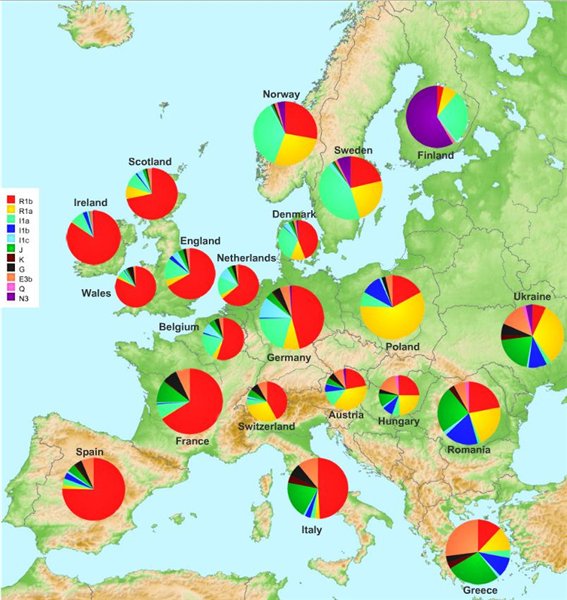Image may be NSFW.
Clik here to view.
Image may be NSFW.
Clik here to view.
Image may be NSFW.
Clik here to view.
The genetic composition of the Norwegian population was investigated by analysing polymorphisms associated with both the mitochondrial DNA (mtDNA) and Y chromosome loci in a sample of 74 Norwegian males. The combination of their uniparental mode of inheritance and the absence of recombination make these haplotypic stretches of DNA the tools of choice in evaluating the different components of a population’s gene pool. The sequencing of the Dloop and two diagnostic RFLPs (AluI 7025 and HinfI at 12 308) allowed us to classify the mtDNA molecules in 10 previously described groups.
As for the Y chromosome the combination of binary markers and microsatellites allowed us to compare our results to those obtained elsewhere in Europe. Both mtDNA and Y chromosome polymorphisms showed a noticeable genetic affinity between Norwegians and central Europeans, especially Germans. When the phylogeographic analysis of the Y chromosome haplotypes was attempted some interesting clues on the peopling of Norway emerged.
Although Y chromosome binary and microsatellite data indicate that 80% of the haplotypes are closely related to Central and western Europeans, the remainder share a unique binary marker (M17) common in eastern Europeans with informative microsatellite haplotypes suggesting a different demographic history. Other minor genetic influences on the Norwegian population from Uralic speakers and Mediterranean populations were also highlighted.
XXX
Introduction
Y chromosome specific and mtDNA polymorphisms, which are uniparentally inherited and are not reshuffled by recombination, are particularly useful tools for investigations involving the genetic structure and the history of human populations. Progress in elucidating Y chromosome variation has catalysed the simultaneous study of both loci. In many cases different pictures emerged that have been attributed to possible differential migration patterns or other demographic phenomena.
Recent studies involving Y chromosome and mtDNA sequence variation, have recently provided a refined portrait of the genetic variability of Scandinavian and northern European populations. These studies have also allowed the authors to make inferences on the relations between different populations of linguistic northern European population, to reappraise the origin of the Saami and to evaluate the influence of the Norse on other North Atlantic populations.
These studies however, did not specifically address the possible origin of the Norwegians and the prehistoric migrations that affected Norway and Scandinavia. Here we report the results from Norwegian samples studied at relevant Y chromosome and mtDNA markers that have recently been used to reconstruct the prehistory of human groups in Europe.
The haplotypes defined by these polymorphisms were extremely useful in understanding the re-peopling of Europe that occurred following the Last Glacial Maximum (LGM), the demic diffusion of Near Eastern agricuturalists that introduced agriculture in Europe and the migration spread of Finno-Ugric Uralic speakers into Europe. Archaeological and genetic data indicates that these events strongly influenced the peopling of Norway and Scandinavia.
The improvement of the climatic conditions following the end of the last glaciation about 12 000 years ago gradually exposed the Scandinavian Peninsula, opening it to colonisation. Archaeological evidence suggests that groups of hunter-gatherers migrated from present day Poland and nearby regions. The subsequent arrival of agriculture to the Scandinavian Peninsula and possibly the Indo-European languages transformed the lifestyle and possibly also influenced the indigenous gene pool.
Finally, UralicFinno-Ugric speakers arriving in northern Scandinavia, probably from a region west of the Urals, had sporadic contacts with Norwegians. Here we define the genetic composition of Norway and attempt to distinguish possible signatures of these prehistoric events and to what extent: they involved gender modulated demographic phenomena.
Filed under: Uncategorized Image may be NSFW.
Clik here to view.
Clik here to view.
